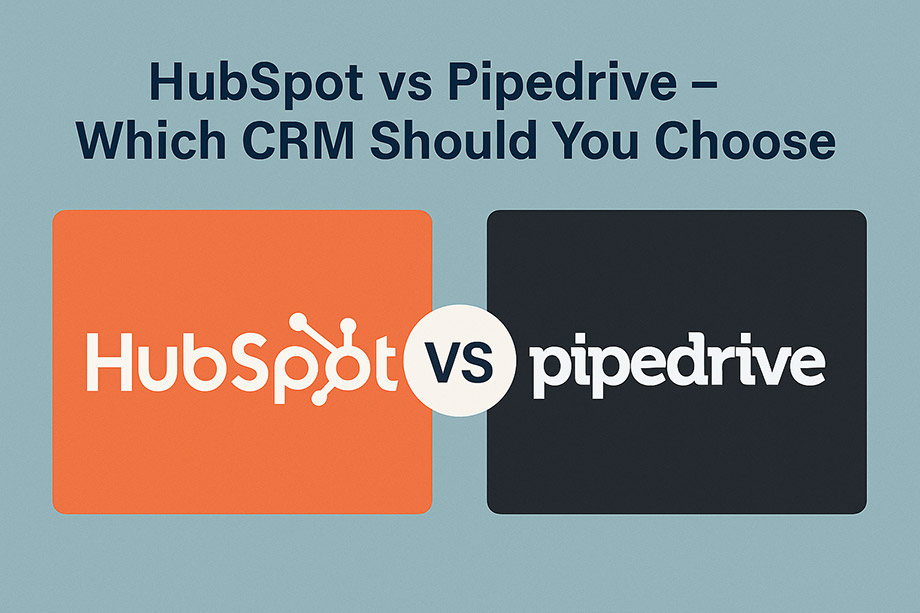HubSpot vs Pipedrive – Which CRM Should You Choose in 2025?

When deciding between HubSpot vs Pipedrive, understanding the strengths and weaknesses of each CRM is crucial. Both platforms are popular choices for managing sales pipelines and customer relationships, but they serve different business needs. This guide will help you compare features, pricing, and usability to choose the best fit for your company.
What Are HubSpot and Pipedrive?
HubSpot is an all-in-one CRM platform that combines marketing, sales, and customer service tools. It’s designed to help businesses grow by offering automation, detailed reporting, and seamless integration across departments.
Pipedrive is a sales-focused CRM built around managing your sales pipeline visually. It’s simple, intuitive, and designed for sales teams who want to focus on closing deals without extra complexity.
Pricing and Plans
HubSpot offers a free CRM with basic features suitable for startups. Paid plans start at about £45 per month but can increase significantly depending on the features and number of users. HubSpot’s pricing grows as you add marketing automation, customer service tools, or more advanced sales features.
Pipedrive is more affordable upfront, starting at around £12 per user per month. It offers tiered plans that unlock more automation and reporting features as you upgrade. For small to medium sales teams, Pipedrive provides strong value without the higher price tag.
HubSpot vs Pipedrive Feature Comparison Table
| Feature | HubSpot | Pipedrive |
|---|---|---|
| Primary Focus | All-in-one CRM (Marketing, Sales, Service) | Sales pipeline management |
| Starting Price | Free plan available; paid from £45/month | From £12/user/month |
| Marketing Tools | Extensive email marketing & automation | Limited marketing features |
| Sales Pipeline | Customizable pipelines + automation | Visual drag-and-drop pipeline |
| Customer Support | Live chat, ticketing, knowledge base | Email/chat support, clear documentation |
| Integrations | Hundreds of apps including analytics | Key sales & productivity apps |
| Ease of Use | Feature-rich but steeper learning curve | Simple, intuitive, easy to adopt |
| Reporting & Analytics | Advanced dashboards & sales/marketing reports | Basic to advanced reporting |
| Mobile App | Yes | Yes |
| Ideal For | Medium to large businesses with marketing & sales needs | Small to medium sales teams |
Ease of Use
Pipedrive is often praised for its straightforward interface and low learning curve. New users can start managing deals quickly without extensive training.
HubSpot offers a more powerful but complex platform. Its interface is clean but packed with features, which can take time for teams to fully master, especially when using marketing or service hubs alongside the CRM.
Integrations and Ecosystem
HubSpot boasts a massive app marketplace, allowing you to connect sales, marketing, customer service, and analytics tools all in one platform. This makes it ideal if your business wants a centralized system.
Pipedrive focuses on essential sales integrations. It supports key apps for communication and productivity but doesn’t have as extensive an ecosystem as HubSpot.
Customer Support and Resources
HubSpot provides extensive resources including webinars, an academy, community forums, and responsive support channels. It’s great if your team benefits from structured learning.
Pipedrive offers solid email and chat support with a clear knowledge base, but fewer training programs. This fits teams looking for straightforward help without a steep learning curve.
Who Should Choose HubSpot?
If your business needs a comprehensive solution that unites marketing, sales, and customer support, and you’re ready to invest time and budget into growing with a scalable platform, HubSpot is a top choice. It’s especially suited for medium to large businesses or those with complex marketing needs.
Who Should Choose Pipedrive?
If your focus is mainly on managing sales pipelines simply and affordably, and you want a tool your team can adopt quickly, Pipedrive is ideal. Small to medium-sized sales teams, startups, and businesses looking for a sales-first CRM will benefit most.
Final Thoughts
HubSpot and Pipedrive both bring valuable features to the table but serve different needs. HubSpot’s power and all-in-one approach come with complexity and a higher price. Pipedrive keeps it simple, focusing on pipeline management at a budget-friendly price.
Before deciding, consider your business size, budget, and which features will impact your workflow most. Both offer free trials, so try them out and see which fits your team best.

